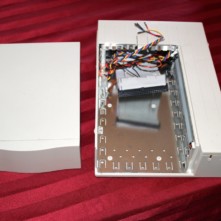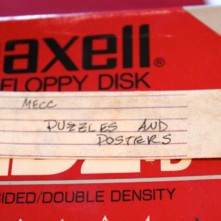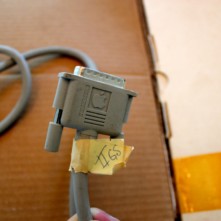Dust cover
| September 12th, 2016 8:49 AM by Ken Gagne | Filed under Hacks & mods; 1 comment. |
I’m someone who likes to keep his Apple II at the ready: you never know when you’ll need to convert a disk image, access an old document, or just chill with a round of Oregon Trail. At my last two day jobs, I had easy access to my IIGS, with it occupying a position of prominence on my office desk, right next to my work-supplied machine. It was a great diversion, conversation piece, and point of pride.
Sadly, my current workplace has not yet been graced by my favorite retrocomputer. Bringing outside, unmanaged machines into a HIPAA-compliant environment is always frowned upon; that and other factors have compounded to leave my Apple IIGS at home, where it’s kept in storage.
Fortunately, I recently cleaned and reorganized my unfinished basement such that my Apple II gear now has a dedicated workspace. It’s not convenient, but at least it’s neat, visible, and easy to find.
Still, a basement is a basement, and all the dust and other particles from elsewhere in the house will eventually settle there. Wanting to keep my Apple II clean from falling particulates but lacking the rolltop desk of my childhood, I asked on Facebook‘s Apple II Enthusiasts group, "Any recommendations for a dust cover?"
I was surprised by many of the answers I received, which included Saran wrap, garbage bags, and pillow cases. All these affordable, makeshift approaches were offered sincerely, but they didn’t strike me as particularly retro or especially classy — an Apple II doesn’t deserve to ever be placed in a garbage bag!!
Sean Fahey of A2Central.com to the rescue: he pointed me to an eBay listing for a "Heavy Duty Clear Vinyl Waterproof Desktop Computer Monitor & Keyboard Dust Cover". The well-rated seller has hundreds of the item available for only $14.90 each with free shipping within the USA. The product arrived 48 hours after I ordered it and came with two separate covers: one each for the computer and the keyboard. The computer case is clear, sturdy, and spacious rather than form-fitting (measuring 19" tall, 17" wide and 16" deep). In this photo, you can see it enveloping the Apple II with room to spare:
Since the cover is hardly touching the Apple II itself, it comes off easy, making for easy access to the machine, which might not have been the case with a garbage bag or plastic wrap. (While those would be good for a computer in storage, I can’t imagine them facilitating use of the protected Apple II.)
So thanks, Sean, for steering me to a product that meets both my functional and aesthetic needs!





















